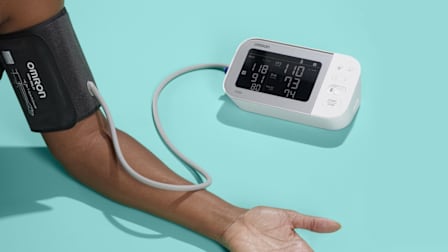Best Blood Pressure Monitors for $50 or Less
These budget-friendly devices can help you control your hypertension
When you shop through retailer links on our site, we may earn affiliate commissions. 100% of the fees we collect are used to support our nonprofit mission. Learn more.

If you have hypertension, monitoring your blood pressure at home can be a good way to keep a close eye on your numbers. Research suggests that self-monitoring with a home blood pressure monitor—which can cost from $20 to $100—may even help you get your blood pressure under control, particularly when you first start monitoring.
But will a cheaper drugstore model work well? Our home monitor tests, which evaluate accuracy, comfort, and ease of use, found budget models that get the job done, says CR testing lead Susan Booth.
The blood pressure monitors below, listed in alphabetical order by type, even outperform some of the $90 and $100 models we tested.
Experts often recommend upper arm monitors over wrist monitors, because they tend to be more accurate. Still, upper arm cuffs don’t fit everyone, and you can get accurate readings with wrist monitors, too, as long as you position your wrist carefully (see our story on wrist monitors for more on how to get an accurate reading).
For more information, see our blood pressure monitor buying guide. Members can also access our full blood pressure monitor ratings.
Arm Monitors
This A&D Medical device got top marks for accuracy. It has a one-size-fits-most (8.6 to 16.5 inches) flexible nylon upper arm cuff that may be difficult for some users to wrap around their own arm and align correctly. The nylon cuff is stiff and molds to fit the arm. The Velcro bond on the cuff is strong and difficult to separate at times. There is a symbol that appears on the screen if you move during the measurement, which can be a helpful clue that you may want to take another reading. A larger cuff (12.2 to 17.7 inches) may be purchased separately.
This Omron model has a one-size-fits-most soft D-ring cuff (9 to 17 inches) that was easy for testers to wrap around their arms and align. This model is very basic without extra features (no hypertension indicator and no Bluetooth connection), but it still got top marks for accuracy. It stores up to 14 readings for one user. Its simplicity allows for a clean, easy-to-read display but the unavailability of date and time stamps on the readings could be an inconvenience for some. The hose connection to the port is tight but it doesn’t lock in like some of the other Omron units. A 7- to 9-inch cuff can be purchased separately.
Wrist Monitors
The Equate wrist monitor has a one-size-fits-most (5.3 to 7.7 inches) cuff that testers found was easy to wrap around their own wrists. It offers similar accuracy to the Omron BP6350 at a lower price point. The cuff and the Velcro are a little stiffer than other tested wrist cuffs but not at the expense of comfort. One nice feature: You can fold any extra cuff material over and Velcro it in place to keep it out of the way. To ensure you are holding the unit at heart level during a reading (the correct height during a measurement), you position it until you line up your sight so that a blue LED light is centered and shines brightest (this is a judgment and may be challenging for some). A color-coded risk classification bar indicator near the screen visually indicates where within the American Heart Association guidelines the measurements fall. Testers deemed it noisier than other units.



































